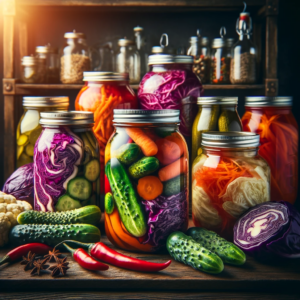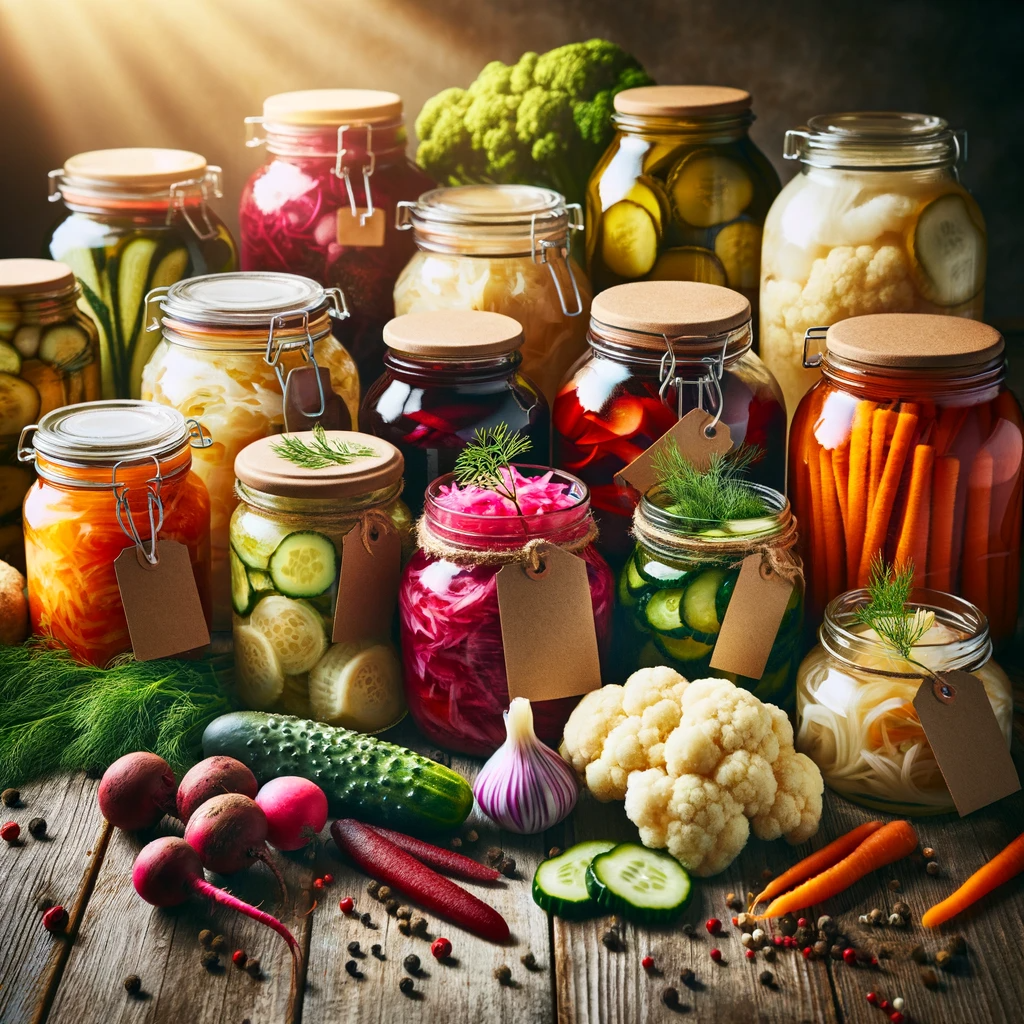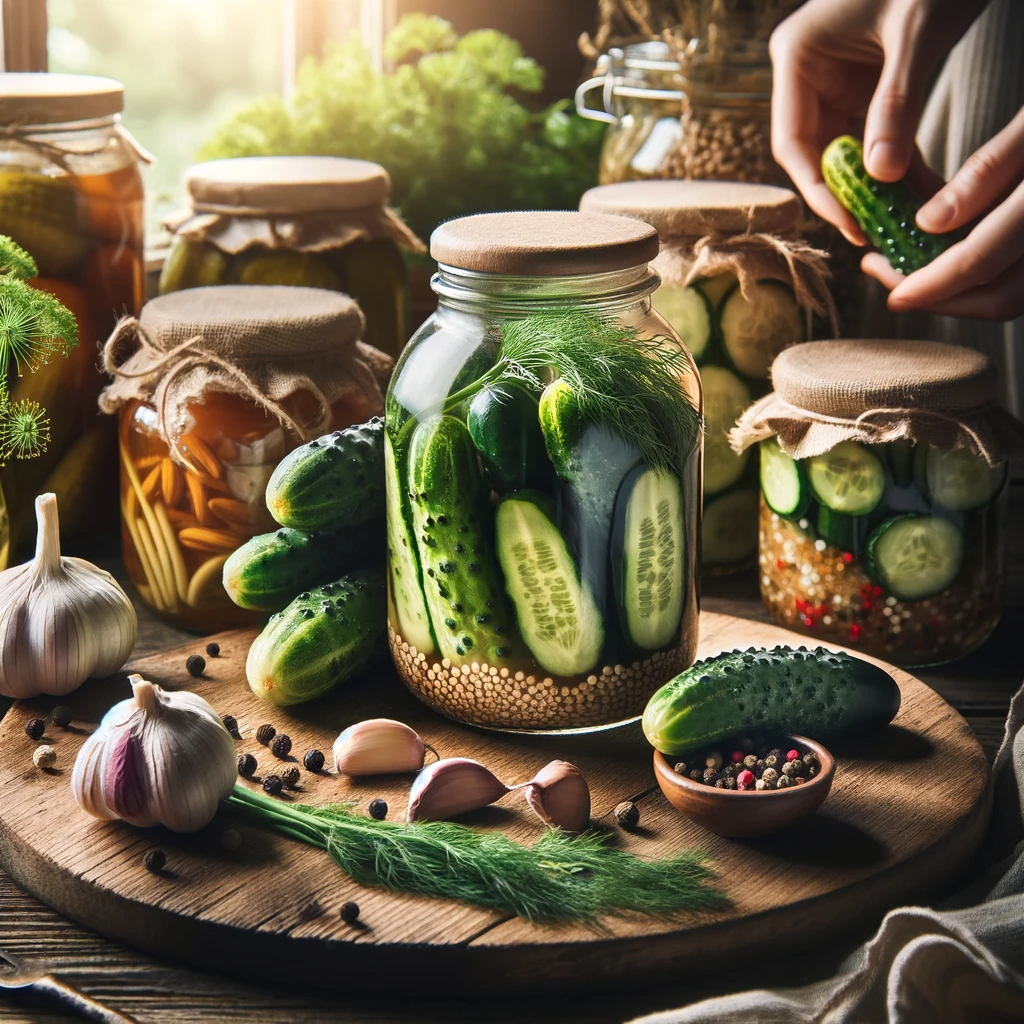Learn How To Ferment Vegetables: The Art of Fermentation

Welcome to the ancient and nourishing world of vegetable fermentation, a practice that marries the art of preservation with the science of probiotics. In the journey toward sustainable living and zero-waste households, fermentation stands out as a beacon of self-sufficiency and health. This guide delves deep into the process, answering your burning questions – from the basics to the intricacies of fermenting without specialized equipment. Let’s embark on this transformative culinary adventure together.
The Basics of Vegetable Fermentation
Fermentation is the transformative process of converting carbohydrates to alcohol or organic acids using microorganisms—yeasts or bacteria—under anaerobic conditions. This method not only preserves the vegetables but also creates beneficial enzymes, b-vitamins, Omega-3 fatty acids, and various strains of probiotics. Historically, it has been a cornerstone of food preservation, long before refrigeration entered our homes. Scientifically, it’s the lactic acid bacteria that are the heroes, turning your cabbage into sauerkraut and your cucumbers into pickles.
Preparing for Fermentation
Choose fresh, preferably organic vegetables as your starting point. The fresher the produce, the more vibrant the fermentation results will be. Cleaning them thoroughly is essential to remove any unwanted bacteria that might interfere with the fermentation process. It’s not just about removing dirt; it’s about preparing a blank canvas for the good bacteria to create their masterpiece.
Fermentation Equipment
To get started, you’ll need a few key pieces of equipment: a fermentation vessel, weights to keep the vegetables submerged, and a cover to create an anaerobic environment. While specialized equipment like airlocks can make the process easier, they are not strictly necessary.
The Fermentation Process
Now, to the heart of the matter – fermenting your vegetables. Begin by submerging your vegetables in a brine solution, ensuring they are completely covered. The brine creates an anaerobic environment where lactic acid bacteria thrive. Over the course of several days to weeks, these bacteria will ferment the sugars in the vegetables, producing a tangy, flavorful preserved product.
How do you ferment vegetables without an airlock?
It’s a common misconception that you need an airlock to ferment vegetables. While an airlock can help prevent contamination by allowing gases to escape without letting air in, it’s not the only way. You can also use a tight lid and ‘burp’ it daily or use a cloth cover secured with a rubber band. This ensures the release of gases and prevents mold growth.
Can you ferment vegetables without vinegar?
Many people confuse fermenting with pickling. While vinegar can be used to pickle vegetables, it’s not necessary for fermentation. Fermentation relies on lactic acid, naturally produced during the process, to preserve the vegetables. This section clarifies the difference and emphasizes the natural, self-sufficient aspect of lacto-fermentation.
Flavoring and Customizing
The beauty of fermentation is in its versatility. You can add a range of herbs and spices to create unique flavor profiles. From classic dill and garlic to bold spices like chili and turmeric, the possibilities are endless. It’s a chance to get creative and tailor your ferments to your taste buds, making every batch a personalized culinary creation.
Caring for Your Fermented Vegetables
Once fermented, your vegetables should be stored properly to maintain their quality. They can be kept at room temperature for a more active fermentation or stored in the refrigerator to slow down the process. This section also addresses troubleshooting common issues like mold, off-odors, and texture changes, ensuring your fermenting endeavors are successful and safe.
From Scraps to Soil: The Zero-Waste Cycle
After enjoying your fermented delights, the journey doesn’t end. The leftover scraps can be a valuable addition to your compost bin, contributing to a nutrient-rich soil amendment for your garden. This practice embodies the zero-waste philosophy and completes the cycle from scraps to soil, perfectly aligning with our Guide: From Scraps to Soil.
Health Benefits and Usage
Beyond preservation, fermented vegetables offer a host of health benefits. They are rich in probiotics, which are essential for gut health, and can be a delicious addition to your diet. From salads and sandwiches to creative culinary concoctions, fermented vegetables can elevate the flavor and nutritional value of your meals, making them a staple in a health-conscious kitchen.
Incorporating Fermentation into Your Zero-Waste Journey
Embracing fermentation is a significant step in a zero-waste lifestyle. We’ll connect the dots between the principles of zero-waste living and the practice of fermentation, illustrating how this age-old technique supports modern sustainability goals.
Lacto-Fermented Honey Garlic Carrots Recipe
Ingredients:
- 1 pound of organic carrots
- 4 cloves of garlic, peeled and smashed
- 2 tablespoons of raw honey (optional for added flavor)
- 1 tablespoon of non-iodized salt (sea salt or kosher salt)
- 4 cups of filtered water (chlorine-free)
- Fresh dill or other herbs (optional)
- 1 teaspoon of whole peppercorns (optional)
Equipment:
- 1-quart wide-mouth mason jar
- Fermentation weights or a small zip-top bag filled with brine
- Cheesecloth or coffee filter
- Rubber band or canning ring
Instructions:
- Prepare the Brine: Dissolve the salt in the filtered water to create a brine. Allow it to cool to room temperature before use.
- Prepare the Carrots: Wash and cut the carrots into sticks that fit in your mason jar.
- Flavoring: Place the garlic, honey, dill, and peppercorns at the bottom of the jar. Add the carrot sticks on top.
- Add the Brine: Pour the brine over the carrots, ensuring they are submerged. Use a fermentation weight to keep them under the brine.
- Cover the Jar: Cover with cheesecloth and secure with a rubber band.
- Fermentation: Store the jar at room temperature for 1-2 weeks, checking daily.
- Taste Test: Once fermented to your liking, seal the jar and store in the refrigerator.
- Enjoy: Serve as a snack, salad addition, or meal accompaniment.
For more tips on growing your own organic carrots to use in recipes like this, check out our guide on How to Grow Carrots During Winter.
Frequently Asked Questions (FAQs) About Fermenting Vegetables
How to Ferment Vegetables in a Mason Jar?
Fermenting vegetables in a mason jar is simple. Start by preparing your vegetables and packing them tightly into the jar. Mix water with the appropriate amount of salt to create a brine and pour it over the vegetables, ensuring they are completely submerged. Seal the jar with a lid, leaving some space for gases to escape or use a special fermentation lid, and store it at room temperature out of direct sunlight for several days to a few weeks, depending on your taste preference.
How to Ferment Vegetables: Recipes?
Recipes for fermenting vegetables vary widely, but a basic formula is to use about 2-3% salt by weight of the vegetables. You can add spices and herbs for flavor. For example, a simple sauerkraut recipe involves thinly slicing cabbage, massaging it with salt, and packing it into a jar with optional caraway seeds before covering it with brine.
How to Naturally Ferment Vegetables?
Naturally fermenting vegetables involves creating conditions that favor the growth of naturally occurring beneficial bacteria. This is typically achieved by submerging the vegetables in a saltwater brine, which inhibits harmful bacteria and allows the lactic acid bacteria present on the vegetables to thrive, fermenting the vegetables over time.
How Long to Ferment Vegetables?
The fermentation time for vegetables can vary depending on the vegetable type, the size of the cut pieces, the temperature of the environment, and your taste preferences. A general guideline is anywhere from 3 days to several weeks. Taste test at regular intervals to find the right balance for you.
How Much Salt to Ferment Vegetables?
The amount of salt used can affect both the taste and safety of your fermented vegetables. A general rule of thumb is to use 2-3% salt by weight of the prepared vegetables. This equates to about 2 to 3 tablespoons of salt per quart of water if you are making a brine.
How Long Does it Take to Ferment Vegetables?
The fermentation time is similar to ‘how long to ferment vegetables’ and can range from a few days to several weeks. Factors like the salt concentration, ambient temperature, and the specific types of vegetables all play a role in the fermentation time.
How Long to Lacto-Ferment Vegetables?
Lacto-fermentation, named after the lactic acid that’s produced, usually takes about 3 days to a few weeks to reach the desired level of sourness. The process can be faster in warmer temperatures and slower in cooler ones. Monitoring the taste and smell is the best way to determine when the fermentation is complete.
How Many Days to Ferment Vegetables?
Again, the number of days to ferment vegetables will vary. A small batch of vegetables may only need a few days, while larger batches or different vegetable types may benefit from a longer fermentation period. Start tasting at around the 3-day mark and decide based on your personal preference for flavor and texture.



Pingback: Preserving Your Winter Harvest: Methods to Store and Use
Pingback: Which Vegetables Can You Ferment? Top 7
Pingback: How to Ferment Pickles
Pingback: Vertical Gardening Indoor
Pingback: How to Compost Banana Peels?